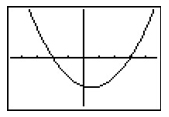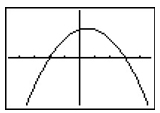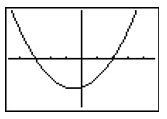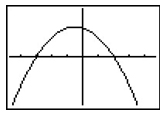



A quadratic function has zeros at -2 and 3 and its graph has a maximum point. Which graph below best represents this function?
| A. |  |
B. |  |
| C. |  |
D. |  |
A
Incorrect. This graph has a minimum not a maximum.
B
Correct!! The graph crosses the x-axis at (-2,0) and (3, 0) and opens downward, thus having one maximum point at its vertex.
C
Incorrect. This graph has a minimum not a maximum and roots are -3 and 2.
D
Incorrect. The roots here are -3 and 2.
A homeowner uses 800 feet of fencing to enclose a dog run in his back yard. Write an equation expressing the area, A, of the rectangular dog run as a function of w, the width of the rectangle.
A. -w2 + 800w = A
Incorrect. You must have thought that the length of the rectangle could be represented by 800 − w. The length should be 400 − w because of the relationship of the length, width, and perimeter of a rectangle.
B. w2 − 400w = A
Incorrect. This one will give you a negative value for the length and a minimum area instead of a maximum area (hint: the parabola must open downward).
C. -w2 + 400w = A
Correct! If the width is “w”, then the length must be “400 − w,” so the area is the product w(400 − w).
D. -2w2 + 400w = A
Incorrect. You must have thought that the length of the rectangle could be represented by 400 − 2w. The length should be 400 − w because of the relationship of the length, width, and perimeter of a rectangle.
Which quadratic function has a minimum but no real zeros?
Cory described a quadratic function as one that has two real zeros and a maximum. Which table of values best represents Cory’s function?
| A. |
|
B. |
|
||||||||||||||||||||||||
| C. |
|
D. |
|
A
Correct! The two real zeros (or x-intercepts) occur at (-1, 0) and (3, 0) and the maximum (vertex) occurs at (1, 4) with y-values less in both directions.
B
Incorrect. By looking at the y-values, you can see that all the points on this parabola are above the x-axis--no real zeros. Also, instead of a maximum, this parabola has a minimum.
C
Incorrect. Looking at the y-values, you can see that all the points on this parabola are below the x-axis--no real zeros. Also, this parabola opens downward and has a maximum, but the maximum is below the x-axis.
D
Incorrect. This parabola crosses the x-axis, so has real zeros, but has a minimum at (2, -5), not a maximum.
Which of the following equations is that of a quadratic function with a minimum in the 4th Quadrant and two real zeros?